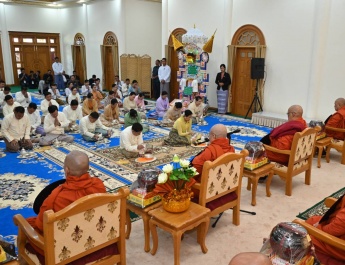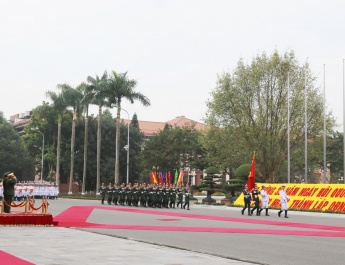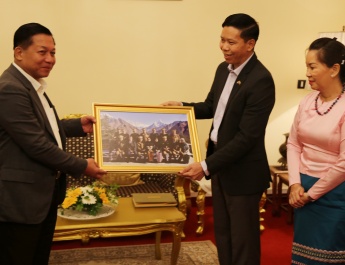NAY PYI TAW July 2
A work coordination meeting on national economic development took place at the State Administration Council Chairman’s Office here this afternoon, addressed by Chairman of State Administration Council Prime Minister Senior General Min Aung Hlaing.
Also present were SAC members, union ministers, the Nay Pyi Taw Council chair, deputy ministers, and departmental officials. Region/state chief ministers took part in the meeting through video conferencing.
National economic development through the development of agriculture production
In his keynote address, the Senior General said the main business of the country is the production industry based on agriculture production. Prices of food products must be maintained at an affordable level by boosting production of basic food items including rice, edible oil, meat and fish. A constant encouragement has been given by the Senior General for progress of the agriculture-based production industry. The production industry must be developed through the application of the existing favourable foundations for farming activities. Although it grows crops such as groundnut, sesame, sunflower and soybean, Myanmar is still importing cooking oil due to domestic insufficiency. Officials must always push for ensuring local oil sufficiency.
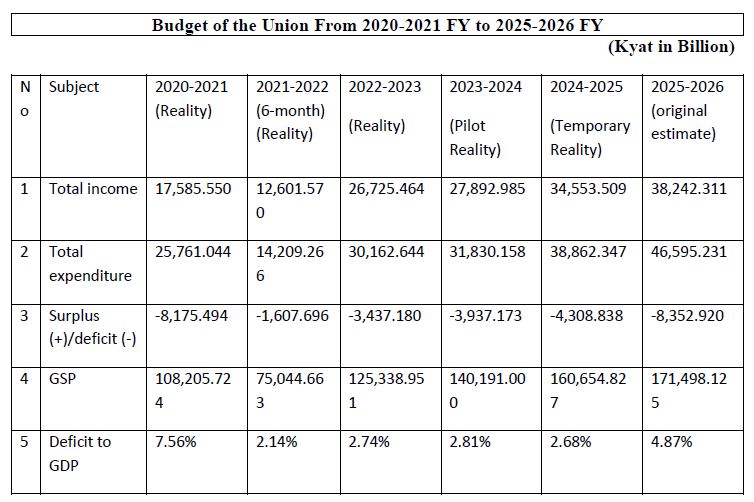
Economy of a nation is measured by its GDP. The country’s GDP was US$-76.4 billion in the financial year 2024-2025, and the target for FY 2025-2026 is US$-81.6 billion, which is an increase of US$-5.2 billion. The World Bank’s estimation for the economy was 2.5 percent up, but the global financial body’s current estimation was 2.5 percent down. But it is found that figures and data used in calculating the GDP are imperfect and inaccurate. Effective work is what the country really needs. Although there are estimations for negative GDP results, the country folks can turn the tide.
Myanmar’s GDP is low when compared with the other ASEAN countries and neighbours. Hence, utmost efforts are required for achieving GDP growth through the development of the production industry. Recently, the Senior General had attended the fourth Eurasian Economic Forum (EEF) 2025 in Belarus, which is a country relying on agro-based industries. Its GDP was US$-73.1 billion, and the country is exporting from US$-6.8 billion to 8.2 billion worth of farm products. At the same time, Myanmar’s earning from agriculture exports was just US$-4.8 billion, which is only about half of Belarus’s. Hence, development of modern farming is obligatory for Myanmar. Although participation in the forum was the main issue, the Senior General took time in visiting the said industry. Although its area and population are smaller than Myanmar, Belarus’s has a higher GDP. Belarus uses modern farming methods and is exporting a large amount of agricultural products. It is one of the global countries that is exporting modern tractors. It is also using advanced machinery in milk cow farms and exporting dairy products.
During the visit to Republic of Buryatia, Russian Federation, it was found that modern methods were applied in conducting breeding pedigree livestock and meat export. Hence, Myanmar will have a successful agriculture production industry, if it can adopt the production methods of the two in conducting farming activities.
Myanmar has 170 percent of rice sufficiency. But some regions and states do not have rice sufficiency. If farmers grow crops systematically meeting the target cultivation with efforts to increase peracre yield of crops, these regions and states will have rice sufficiency. It can be seen that Chin and Shan states and Taninthayi, Magway, Mandalay and Yangon regions do not have rice sufficiency. If these regions and states strive to meet the target cultivation, they will have rice sufficiency except Chin State and Mandalay Region. If they produce quality rice to foreign countries, the country can earn more incomes of foreign exchange. Hence, efforts must be expedited to increase agricultural produce.
Local farmers were urged to follow the methods of seeding and using paddy transplanters in agricultural tasks in regions and states. So, agricultural tasks improved. Only when rows of paddy plants are in correct methods and relevant plots must be filled with set number of paddy plants will paddy plants thrive and per-acre yield increase. As paddy plants can bear ears, seeds and fruits, it is necessary to grow paddy plants systematically for thriving.
It is necessary to emphasize peracre yield of crops as well as expand sown acreage of crops through double cropping. There were 17 million acres of rainfed paddy in 2022-2023. In the entire country, there were 15 million acres of net sown acreage, 2.24 million acres of double-cropped area and 28,000 acres of mixed-cropped areas. The country grew 7.33 million acres of growing paddy alone yearly. If paddy or other crops are planted on these cultivable lands, it will be the best beneficial. There are some 20 million acres of single paddy crop per year across the nation.
Regional and state authorities have to implement agricultural projects to have success. They have to manage systematic cultivation with set number of crop saplings to meet the target cultivation. Moreover, efforts must be made to supply water to the farmlands systematically. It is necessary to carry out agricultural tasks as a must to achieve success. Regional and state chief ministers have to emphasize businesses related to agriculture and livestock farming except the situations of natural disasters. They have to strive to secure success in agriculture and livestock based businesses as a milestone of the government.
Successful undertaking of agriculture and livestock breeding tasks will contribute much to rural development and poverty alleviation
Reviews mentioned that efforts to implement agriculture and livestock projects successfully can contribute much to rural development and poverty alleviation with raising the poverty index of Myanmar. Poverty is based on failure to operating businesses and lack of chances to work due to natural disasters. Some 70 percent of people are residing in the rural area in the country while 30 percent live in urban area. More than 50 percent of them are engaged in agriculture, livestock and forestry sectors. As such, if the country successfully implements agriculture and livestock farming tasks the rural people mainly operate, these efforts can contribute much to poverty alleviation. It is necessary ti implement poverty alleviation successfully with compassion. Moreover, it is necessary to successfully carry out agriculture as well as livestock breeding tasks. The country has great chances to operate raising of chickens, pigs, goats, cows and fish in any places successfully. Agriculture and livestock farms must be expanded to supply livestock, fish, eggs and fish as well as vegetables to all regions depending population. In so doing, rural people will have to enjoy improvement of socioeconomic life. As any agriculture and livestock farms must centre the rural area, rural people can generate increased incomes while reducing poverty rate.
Cotton and bamboo as key drivers for national economic development
Cotton and bamboo have been included as key industries to promote national economic development. Regarding MSMEs (Micro, Small, and Medium Enterprises) based on agricultural and livestock products, efforts have been encouraged since around 2021, and at present, these enterprises have achieved a certain level of success in operation. Globally, MSMEs are also being supported and promoted. When examining MSMEs in our country, most are related to food and beverage products. However, there is a need to produce more marketable goods such as industrial products and agricultural inputs. In production, some goods require processing, while others can be derived directly from nature. For example, bamboo, which grows naturally, can be used to produce a wide range of products. If utilized effectively, it could significantly contribute to national income. Regarding crops, there are approximately 500,000 acres of cotton cultivation. Supporting cotton-based industries would greatly benefit the country’s economic development. Cotton is a crop with high potential for national progress, so efforts should be made to expand and promote it. Cotton and bamboo should be prioritized as key industries for economic growth.
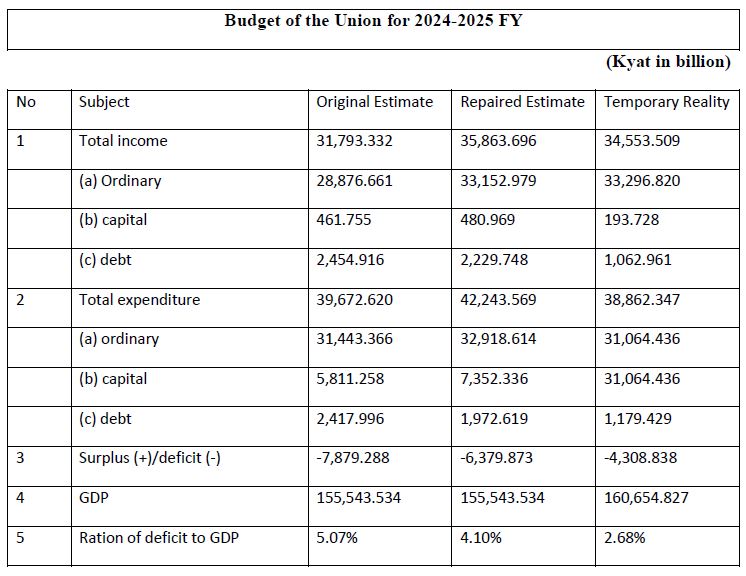
The objectives of supporting MSMEs include sub-stituting imports, boosting the domestic economy, producing high-quality goods for export, and earning foreign exchange. In operating MSMEs, the availability of raw materials is crucial. Therefore, priority is given to MSMEs based on locally produced goods. Essential inputs such as fertilizers, pesticides, fuel, and electricity must also be adequately supplied. Sufficient financial capital and skilled human resources are equally necessary. During visits to support MSMEs across the country, labor shortages were frequently raised as an issue. Therefore, in 2024, data on the working-age population (ages 15 to 65) was collected. According to the figures, the estimated working-age population is 34.806 million, while around 19.141 million are employed in some capacity. There are over 1 million civil servants, 140,000 university students, and 17.130 million registered domestic and migrant workers. Despite having a capable workforce, there is a need to utilize this labor more productively. Although our country has a strong foundation and favorable conditions for employment, actual work implementation is still lacking. Job creation must be facilitated, and the government has already allocated economic development funds to regions and states. Further support will continue as needed. The state will provide necessary capital and technology, but the most crucial aspect is putting in real effort to work.
The World Bank has assessed that Myanmar’s GDP may decline due to conflicts disrupting production activities and the economic damage caused by the Mandalay earthquake. In response, our government has prioritized post-disaster recovery measures, including providing low-interest investment loans to help businesses recover quickly. We are fully committed to revitalizing the affected economy and will continue supporting production growth. For the nation’s economic development, we must encourage those willing to contribute, and we believe these efforts will lead to tangible progress.
Regarding the country’s economic advancement, the Union Minister for Planning and Finance presented key updates. These included the fiscal year’s Union budget revenue and expenditure estimates, the utilization of emergency funds for natural disasters, and financial support allocated to the National Disaster Management Fund. The minister also discussed the draft budget for the 2025-2026 fiscal year, trends in consumer prices and inflation rates, expenditures and remaining balances from the MSME Development Fund, and the establishment and additional funding of the National Economic Promotion Fund, including its distribution to regions and states. The Union Mini-ster for Agriculture, Livestock, and Irrigation reported on efforts to develop the agricultural and livestock sectors while boosting production. The presentation covered export and import volumes, income and expenditure trends from the 2020-2021 to 2024-2025 fiscal years, and a comparative analysis of production and export capacities in neighboring countries. The Union Minister for Energy outlined measures to strengthen the energy sector for economic growth. These included strategies to reduce dependence on imported petroleum products, progress in domestic high-grade fuel production and its benefits, plans to cut fertilizer imports, and key foundational steps needed for the energy sector’s advancement. The Union Minister for Industry detailed initiatives to promote industrial growth and enhance MSME production. This included the formation of supporting committees and commissions, the organization of MSME product exhibitions, efforts to ensure quality in construction-related steel and iron production, and the optimization of cement factory output. The minister also highlighted developments in industrial zones, progress in domestic pharmaceutical manufacturing, and the production performance of state-owned factories across fiscal years.
Afterwards, the attendees discussed and presented a range of issues concerning the nation’s economic development.
In response to the briefings, the Senior General emphasized the importance of ensuring adequate domestic production of pharmaceuticals, particularly those with the highest local demand. To promote MSME development, emphasis should be placed on the use of locally sourced raw materials, increasing production, and expanding export capacity. He stated that in the manufacturing sector, it is essential to focus on producing market-driven products in large quantities with high quality, and then address other necessary requirements.
The Senior General then delivered his concluding remarks. He stated that the topics discussed were constructive, emphasizing that efforts are underway to improve the national economy and reduce the prices of goods. He noted the importance of addressing both immediate concerns and long-term challenges. He stressed that short-term priorities must focus on the country’s economic development. It is essential to enhance manufacturing activities and meet business needs as much as possible. He added that conducting research will enable further improvements in the business sector.
In the agricultural sector, it is necessary to conduct research aimed at cultivating and producing high-yield, high-quality strains that are well-suited to current conditions. It is also necessary for every region and state to implement measures that ensure domestic wheat self-sufficiency. Corn farming is also a national need; therefore, it is necessary to produce high-quality corn raw materials domestically and to export finished corn products. Increasing the production of oilseed crops, such as sunflower, will significantly contribute to achieving domestic oil self-sufficiency. There is a need to conduct research to ensure that crops such as Burmese durian and Sein Talone mango, which are grown in the country, can be cultivated and produced with high quality. If crops suitable for each region are cultivated within designated zones, it will be possible to produce large quantities of high-quality crops in a centralized area. Efforts to increase the production of kitchen crops such as onions, garlic, potatoes, and others will directly benefit farmers.
Research efforts will enhance the production of crops vital to the country and significantly contribute to its economic growth. Similarly, in the farming sector, the local chicken industry serves both domestic and international markets, with necessary animal feed available locally. It is essential to conduct research on livestock farming—including chickens, ducks, pigs, goats, cattle, fish, and shrimp—to improve domestic farming and support those engaged in livestock farming. Further improvements in agricultural and livestock production, coupled with achieving domestic self-sufficiency and increasing exports, will significantly contribute to the country’s economic development. The country is suffering substantial losses due to illegal trade in border areas and the unauthorized extraction of natural resources across various regions. Therefore, instructions were given to regional and state governments to continue systematic monitoring of the situation, and the meeting came to a conclusion in the evening.



